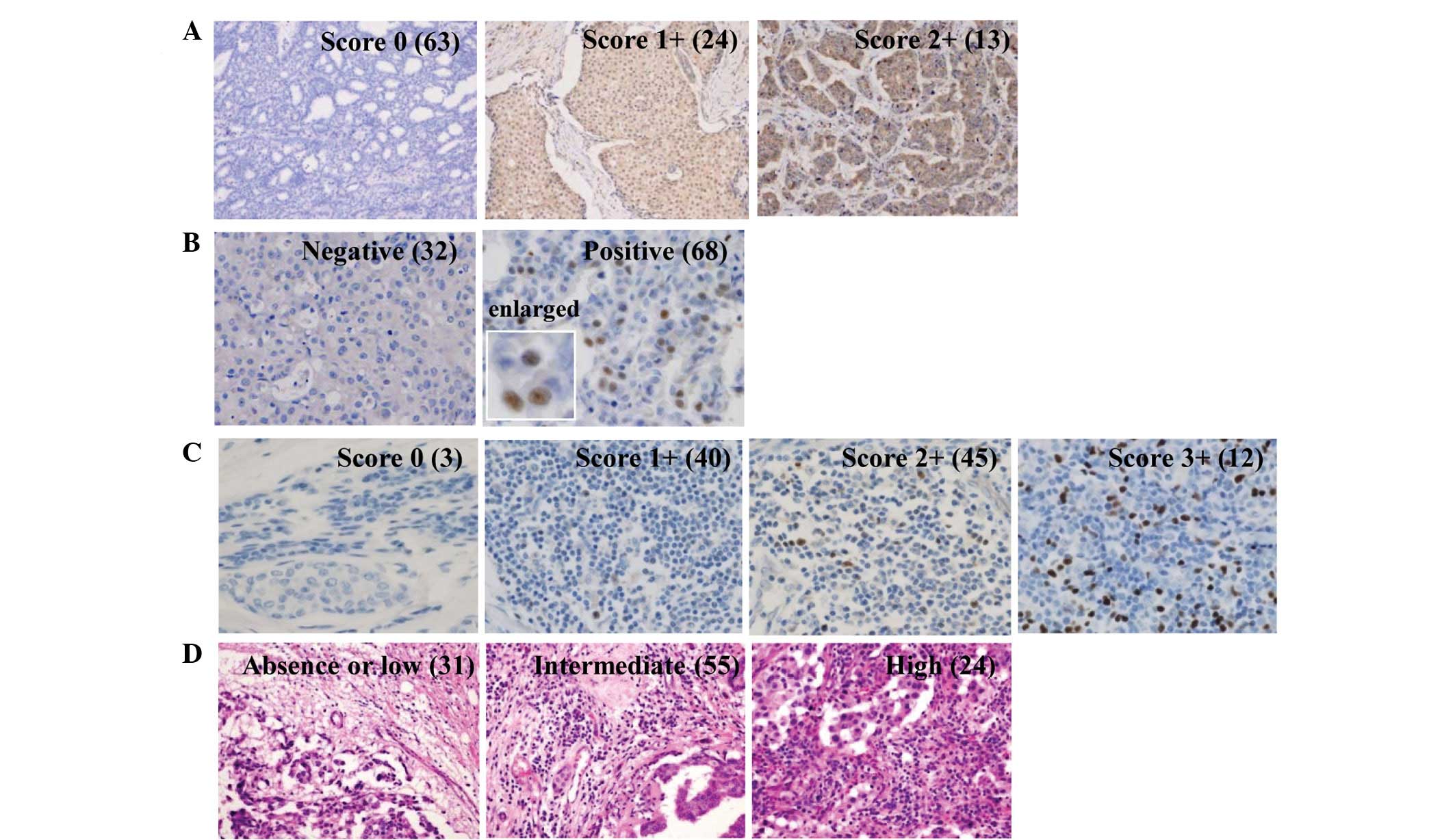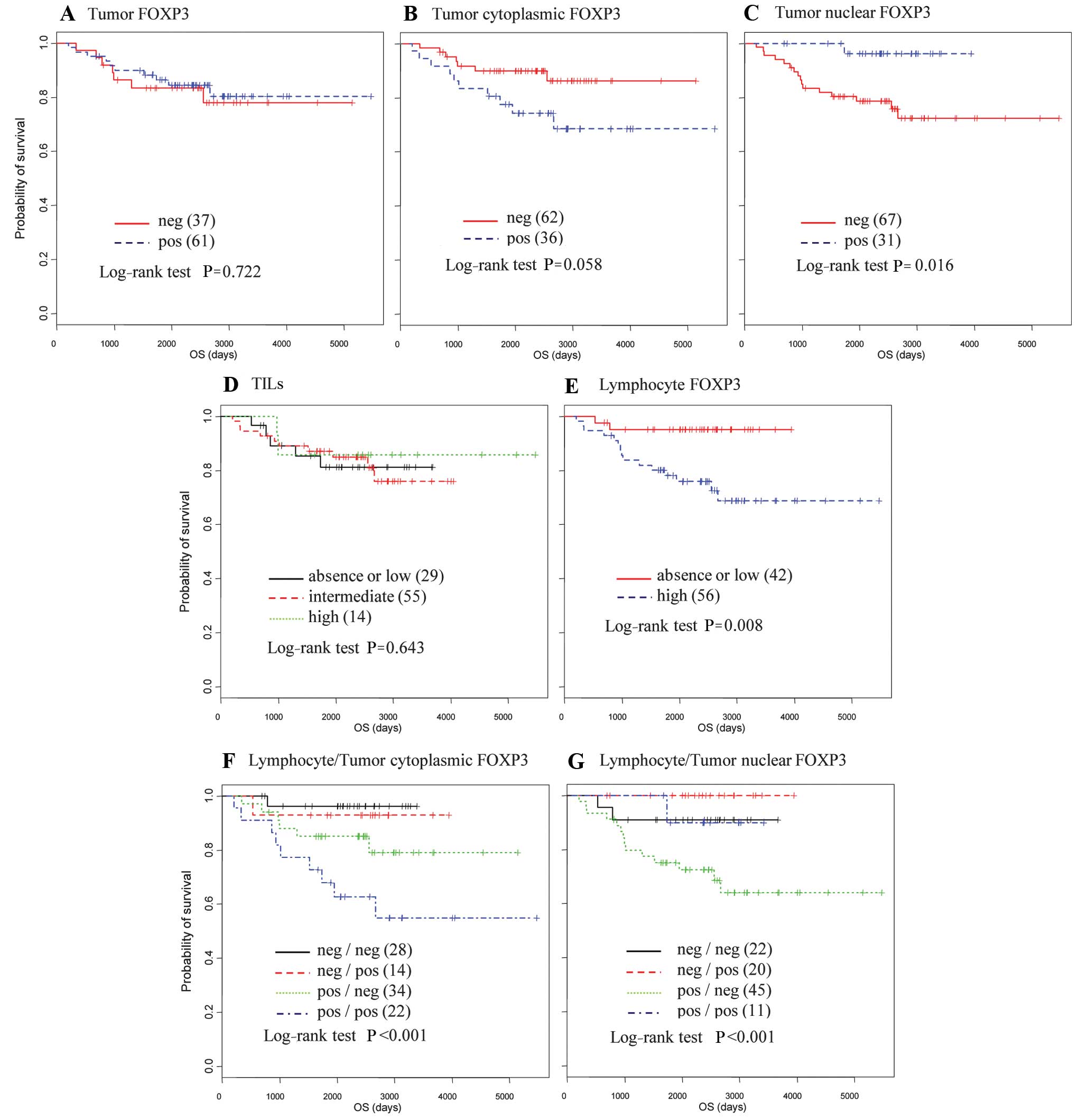|
1.
|
Coffer PJ and Burgering BM: Forkhead-box
transcription factors and their role in the immune system. Nat Rev
Immunol. 4:889–899. 2004. View
Article : Google Scholar : PubMed/NCBI
|
|
2.
|
Hori S, Nomura T and Sakaguchi S: Control
of regulatory T cell development by the transcription factor Foxp3.
Science. 299:1057–1061. 2003. View Article : Google Scholar : PubMed/NCBI
|
|
3.
|
Lopes JE, Torgerson TR, Schubert LA, et
al: Analysis of FOXP3 reveals multiple domains required for its
function as a transcriptional repressor. J Immunol. 177:3133–3142.
2006. View Article : Google Scholar : PubMed/NCBI
|
|
4.
|
Martin F, Ladoire S, Mignot G, Apetoh L
and Ghiringhelli F: Human FOXP3 and cancer. Oncogene. 29:4121–4129.
2010. View Article : Google Scholar : PubMed/NCBI
|
|
5.
|
Sakaguchi S, Ono M, Setoguchi R, et al:
Foxp3+CD25+CD4+natural regulatory
T cells in dominant self-tolerance and autoimmune disease. Immunol
Rev. 212:8–27. 2006.
|
|
6.
|
Liyanage UK, Moore TT, Joo HG, et al:
Prevalence of regulatory T cells is increased in peripheral blood
and tumor microenvironment of patients with pancreas or breast
adenocarcinoma. J Immunol. 169:2756–2761. 2002. View Article : Google Scholar : PubMed/NCBI
|
|
7.
|
Woo EY, Chu CS, Goletz TJ, et al:
Regulatory CD4(+)CD25(+) T cells in tumors from patients with
early-stage non-small cell lung cancer and late-stage ovarian
cancer. Cancer Res. 61:4766–4772. 2001.
|
|
8.
|
Bates GJ, Fox SB, Han C, et al:
Quantification of regulatory T cells enables the identification of
high-risk breast cancer patients and those at risk of late relapse.
J Clin Oncol. 24:5373–5380. 2006. View Article : Google Scholar : PubMed/NCBI
|
|
9.
|
Bohling SD and Allison KH:
Immunosuppressive regulatory T cells are associated with aggressive
breast cancer phenotypes: a potential therapeutic target. Mod
Pathol. 21:1527–1532. 2008. View Article : Google Scholar : PubMed/NCBI
|
|
10.
|
Curiel TJ, Coukos G, Zou L, et al:
Specific recruitment of regulatory T cells in ovarian carcinoma
fosters immune privilege and predicts reduced survival. Nat Med.
10:942–949. 2004. View
Article : Google Scholar : PubMed/NCBI
|
|
11.
|
Gobert M, Treilleux I, Bendriss-Vermare N,
et al: Regulatory T cells recruited through CCL22/CCR4 are
selectively activated in lymphoid infiltrates surrounding primary
breast tumors and lead to an adverse clinical outcome. Cancer Res.
69:2000–2009. 2009. View Article : Google Scholar
|
|
12.
|
Ohara M, Yamaguchi Y, Matsuura K, Murakami
S, Arihiro K and Okada M: Possible involvement of regulatory T
cells in tumor onset and progression in primary breast cancer.
Cancer Immunol Immunother. 58:441–447. 2009. View Article : Google Scholar : PubMed/NCBI
|
|
13.
|
Ebert LM, Tan BS, Browning J, et al: The
regulatory T cell-associated transcription factor FoxP3 is
expressed by tumor cells. Cancer Res. 68:3001–3009. 2008.
View Article : Google Scholar : PubMed/NCBI
|
|
14.
|
Hinz S, Pagerols-Raluy L, Oberg HH, et al:
Foxp3 expression in pancreatic carcinoma cells as a novel mechanism
of immune evasion in cancer. Cancer Res. 67:8344–8350. 2007.
View Article : Google Scholar : PubMed/NCBI
|
|
15.
|
Karanikas V, Speletas M, Zamanakou M, et
al: Foxp3 expression in human cancer cells. J Transl Med. 6:192008.
View Article : Google Scholar : PubMed/NCBI
|
|
16.
|
Zuo T, Wang L, Morrison C, et al: FOXP3 is
an X-linked breast cancer suppressor gene and an important
repressor of the HER-2/ErbB2 oncogene. Cell. 129:1275–1286. 2007.
View Article : Google Scholar : PubMed/NCBI
|
|
17.
|
Wang L, Liu R, Li W, et al: Somatic single
hits inactivate the X-linked tumor suppressor FOXP3 in the
prostate. Cancer Cell. 16:336–346. 2009. View Article : Google Scholar : PubMed/NCBI
|
|
18.
|
Zuo T, Liu R, Zhang H, et al: FOXP3 is a
novel transcriptional repressor for the breast cancer oncogene
SKP2. J Clin Invest. 117:3765–3773. 2007.PubMed/NCBI
|
|
19.
|
Zhang HY and Sun H: Up-regulation of Foxp3
inhibits cell proliferation, migration and invasion in epithelial
ovarian cancer. Cancer Lett. 287:91–97. 2010. View Article : Google Scholar : PubMed/NCBI
|
|
20.
|
Jung DJ, Jin DH, Hong SW, et al: Foxp3
expression in p53-dependent DNA damage responses. J Biol Chem.
285:7995–8002. 2010. View Article : Google Scholar : PubMed/NCBI
|
|
21.
|
Ladoire S, Arnould L, Mignot G, et al:
Presence of Foxp3 expression in tumor cells predicts better
survival in HER2-overexpressing breast cancer patients treated with
neoadjuvant chemotherapy. Breast Cancer Res Treat. 125:65–72. 2011.
View Article : Google Scholar
|
|
22.
|
Liang YJ, Liu HC, Su YX, et al: Foxp3
expressed by tongue squamous cell carcinoma cells correlates with
clinicopathologic features and overall survival in tongue squamous
cell carcinoma patients. Oral Oncol. 47:566–570. 2011. View Article : Google Scholar : PubMed/NCBI
|
|
23.
|
Merlo A, Casalini P, Carcangiu ML, et al:
FOXP3 expression and overall survival in breast cancer. J Clin
Oncol. 27:1746–1752. 2009. View Article : Google Scholar : PubMed/NCBI
|
|
24.
|
Tao H, Mimura Y, Aoe K, et al: Prognostic
potential of FOXP3 expression in non-small cell lung cancer cells
combined with tumor-infiltrating regulatory T cells. Lung Cancer.
75:95–101. 2012. View Article : Google Scholar : PubMed/NCBI
|
|
25.
|
Winerdal ME, Marits P, Winerdal M, et al:
FOXP3 and survival in urinary bladder cancer. BJU Int.
108:1672–1678. 2011. View Article : Google Scholar : PubMed/NCBI
|
|
26.
|
Elston CW and Ellis IO: Pathological
prognostic factors in breast cancer. I. The value of histological
grade in breast cancer: experience from a large study with
long-term follow-up. Histopathology. 19:403–410. 1991. View Article : Google Scholar
|
|
27.
|
Badoual C, Hans S, Rodriguez J, et al:
Prognostic value of tumor-infiltrating CD4+T-cell
subpopulations in head and neck cancers. Clin Cancer Res.
12:465–472. 2006. View Article : Google Scholar : PubMed/NCBI
|
|
28.
|
Carreras J, Lopez-Guillermo A, Fox BC, et
al: High numbers of tumor-infiltrating FOXP3-positive regulatory T
cells are associated with improved overall survival in follicular
lymphoma. Blood. 108:2957–2964. 2006. View Article : Google Scholar : PubMed/NCBI
|
|
29.
|
Salama P, Phillips M, Grieu F, et al:
Tumor-infiltrating FOXP3+ T regulatory cells show strong
prognostic significance in colorectal cancer. J Clin Oncol.
27:186–192. 2009.
|
|
30.
|
Zhou Z, Song X, Li B and Greene MI: FOXP3
and its partners: structural and biochemical insights into the
regulation of FOXP3 activity. Immunol Res. 42:19–28. 2008.
View Article : Google Scholar : PubMed/NCBI
|
|
31.
|
Yu H, Kortylewski M and Pardoll D:
Crosstalk between cancer and immune cells: role of STAT3 in the
tumour microenvironment. Nat Rev Immunol. 7:41–51. 2007. View Article : Google Scholar : PubMed/NCBI
|
|
32.
|
Knupfer H and Preiss R: Significance of
interleukin-6 (IL-6) in breast cancer (review). Breast Cancer Res
Treat. 102:129–135. 2007. View Article : Google Scholar : PubMed/NCBI
|
|
33.
|
Nicolini A, Carpi A and Rossi G: Cytokines
in breast cancer. Cytokine Growth Factor Rev. 17:325–337. 2006.
View Article : Google Scholar
|
















